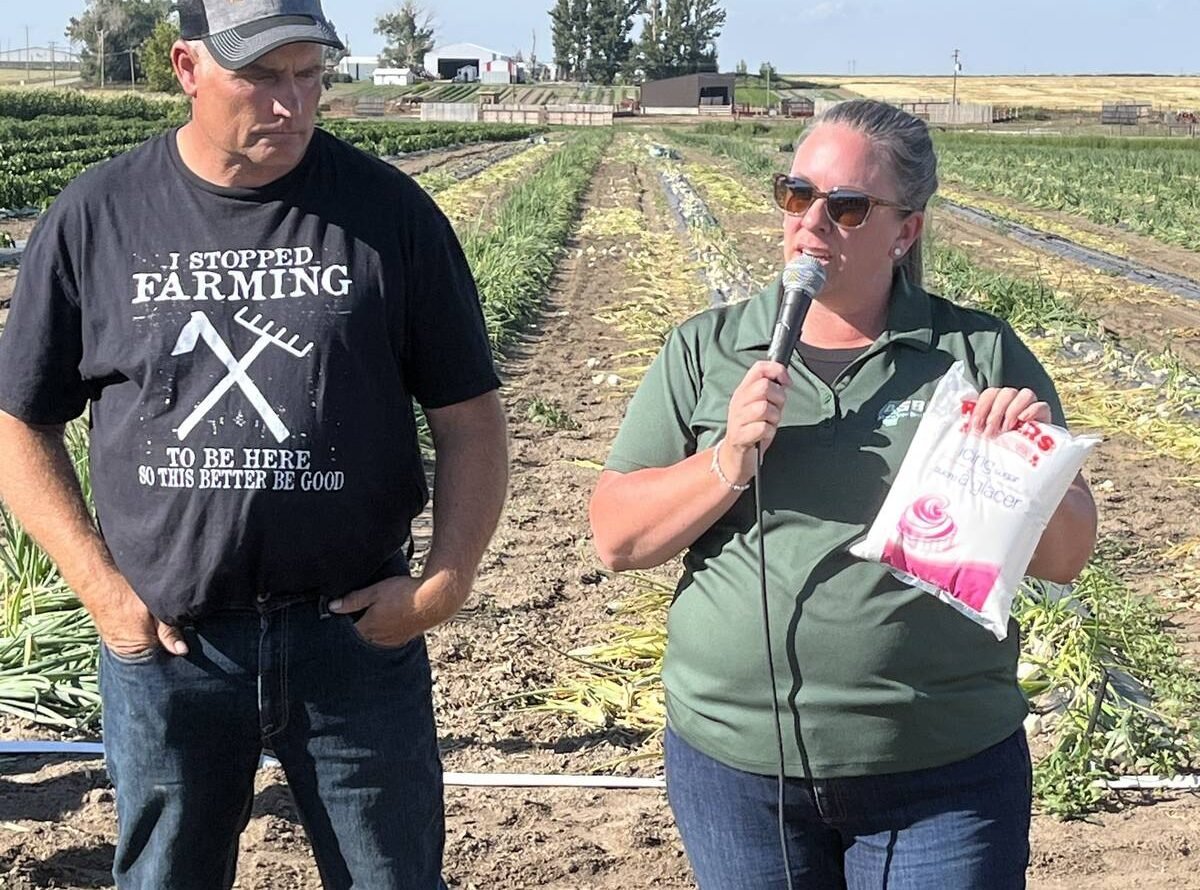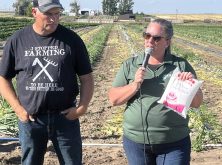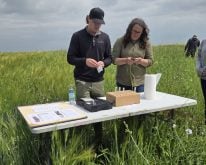MANITOBA
SOUTHWEST
Unseeded land drying
Warm weather in July has dried up soaked fields that went unseeded this spring, allowing producers to spray weeds and plant greenfeed.
Canola crops are under stress because of excess moisture in June and too much heat in July. Some canola fields are bolting and haven’t cabbaged out.
Winter wheat crops are heading, and the crop is rated as average. Fall rye is also rated as average.
Read Also

Alberta’s beets a sweet domestic segment in Canada’s sugar supply
The sugar beet industry is showcased during a Farm to Table tour, as Taber features the last remaining sugar beet processing plant in all of Canada.
Dry weather has helped producers put up feed. Hay yields are reported as average to above average.
CENTRAL
Spraying for sclerotinia
Early seeded canola is nearly finished flowering. Late seeded crop is bolting. Producers are spraying canola for sclerotinia on the ground and from the air.
Soybeans are in the fourth trifoliate stage and plants are flowering. Corn crops have progressed nicely in the warm July weather.
Diamondback moth trap counts are high, but bertha armyworm numbers are low.
Producers have made good progress on their haying operations. Yields are reported as good but quality is below average.
NORTHWEST
Crop development progressing
Warm weather in July has boosted crop development across the region. Many fields that flooded out this spring, including areas north and east of Dauphin, are dry and could use a rain.
Producers in the eastern half of the region are making fungicide application decisions on a field by field basis, based on yield potential.
Wheat is heading around Swan River and Roblin.
Bertha armyworm and diamondback moth counts are increasing.
EASTERN
Late seeded crops recovering
Some drought stress on cereal crops has been reported in parts of the region. Soil moisture is good in most other areas.
Oats and late seeded canola are starting to recover from moisture stress this spring. Flax is flowering and some fields are 12 inches high.
Brown spot and bacterial blight have been reported on soybean leaves. A few soybean fields are showing signs of root rot.
Alfalfa yields of two tons of dry matter per acre have been reported in the southern half of the region.
INTERLAKE
Too wet or too dry
Field conditions vary across the region as some fields remain too wet and other areas would benefit from a shower.
Producers continue to seed greenfeed in fields that were flooded out this spring.
Warm temperatures in July have caused some herbicide stress on annual crops.
Pasture conditions have improved because sun and wind have dried out low-lying areas. Second hay cut has begun on a few fields.
SASKATCHEWAN
SOUTH
Too much water
Excess moisture continues to be a problem in many parts of southern Saskatchewan. Warm weather helped crops in many areas, but other regions received rain and high winds.
In the southeast, 50 percent of fall cereals and 80 percent of spring cereals, oilseeds and pulse crops are behind normal in development. Nearly 90 percent of hay crops were rated as good to excellent. Topsoil moisture in the southeast was rated as 36 percent surplus and 64 percent adequate.
Southwestern Saskatchewan received little rain from July 5-11. Topsoil moisture was 81 percent adequate on cropland and 89 percent adequate on hayland and pastures.
Sixty-four percent of spring cereals, 53 percent of oilseeds and 56 percent of pulse crops were behind normal.
CENTRAL
Hay in good shape
Haying continued in central regions, although some areas received showers, thunderstorms and hail.
Weather was generally warmer and dryer in west-central areas.
Hay quality was rated as 69 percent good to excellent in west-central Saskatchewan and 80 percent good to excellent in eastcentral areas.
Hail was reported in some areas. Leaf diseases affected some crops. Insects, including pea aphids, also caused damage.
Many fields in east-central areas are yellowing due to flooding and excess moisture.
Topsoil moisture throughout central regions is mostly adequate. Some west-central producers could use more moisture. Many in eastcentral areas have too much.
In the west, 59 percent of spring cereals, 62 percent of oilseeds and 69 percent of the pulse crops are at normal stages of development.
In the east, roughly half of the spring seeded crops were behind normal in development.
NORTH
Warm weather needed
Haying advanced in many northern regions, although recurring showers
slowed progress.
Precipitation was highly variable. In general, producers are looking
for warm, dry weather to advance crops and dry out wet fields.
In some regions, crops are drowned out and will not recover.
In the northeast, some canola crops have been worked under or sprayed
out because of excess moisture damage.
Topsoil moisture was 92 to 95 percent adequate as of July 11 and four
to five percent surplus.
In the northeast, 70 percent of spring cereals, 65 percent of
oilseeds and 80 percent of pulse crops were at normal stages of
development.
In the northwest, 76 percent of spring cereals, 59 percent of
oilseeds and 80 percent of pulse crops are normal.
ALBERTA
PEACE
Rain comes in time
Areas that were short of rain around La Crete and High Level received
a few good rains to salvage their crops. Rain has varied from a deluge
to showers across other parts of the Peace.
Some crops are still suffering from early dry conditions. Canola
germination was spotty and crops have continued to be patchy.
Grasshoppers are a big concern. They are past economic threshold
numbers for spraying, but reasonable growing conditions have the crops
ahead of the grasshoppers.
Farmers struggle to bale hay between rains.
CENTRAL
Canola patchy
Crops are average to very good.
Canola is patchy, depending on its germination, but wheat crops are
the best in years.
Sclerotinia is a big concern in canola. High humidity and continual
rain are ideal for the development of the disease. High canola prices
are prompting agrologists to recommend spraying fungicide to help reduce
yield loss.
Farmers are struggling to hay between rain.
Pea crops looking very good, as are winter wheat crops.
NORTHEAST
Canola doing poorly
Patchy rain showers have created patchy canola fields. Canola crops
are some of the poorest in years.
However, agrologists are still recommending spraying fungicides to
control sclerotinia.
High humidity and continual rain showers are ideal for the
development of the disease.
Wheat crops are looking good. Some reports of grasshoppers in the
area.
Haying has just started and pastures are looking healthy after years
of overgrazing because of drought.
NORTHWEST
Excess rain causes problems
The County of Lac Ste. Anne has declared an agriculture emergency
because of excess water. Rain has washed out crops, roads and bridges.
Crop conditions vary from poor to excellent depending on the amount
of rain received in the area. Crops are behind schedule, but wheat crops
look very good.
Farmers are trying to hay between rain, but with little success.
Pastures are good with plenty of growth.
SOUTH
Rain delays haying
Excess moisture across most of southern Alberta and pockets of too
little moisture have farmers wondering what happened to average
rainfalls.
Overall, crops are late compared to most years and are no further
ahead than central Alberta.
Disease has become a serious concern and many farmers are beginning
to spray for sclerotinia.
Stripe rust has been found on most winter wheat fields and has moved
to some spring wheat fields. Farmers are advised to keep a look out for
leaf disease while scouting their fields. Wheat midge is showing up in
fields.
Rain has made haying difficult. A lot of acres are left to cut and
farmers hope for a week without rain.














